|
On this page...
|
Nero Burning ROM by Ahead
is a versatile piece of software. It allows you to create Super
VideoCD's of your photo collection as well.
In this short guide I'll show you how to create your own Photo-Super
VideoCD, which you can playback on your PC and on most standalone
DVD-players.
Tip: If your DVD-player does not support
the use of Super VideoCD, then you might want to consider using
the VideoCD format instead! See Photo
VideoCD for details.
Tip: You can also add movie fragments
to this VideoCD as well!
Tip: When using the menu's in Nero, note
that there is a limitation of 99 photo's on a CD. If you do not
use the menu's, then you will have no limitations on the number
of photo's.
Note: Read the disclaimer
first! |
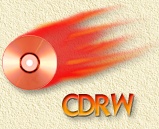
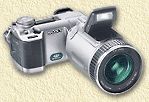
|
Page overview
Step 1: Have the photo files ready
Naturally one needs photo's to be able to add them to
a VideoCD. You can add 1 or more photo's and even add video fragments
- mixing is allowed!
For foto's you can use basically any
common file format, like: GIF, BMP,
JPEG, TIFF and PNG.
For video fragments
one needs to use MPEG2 files, matching the VideoCD standard,
see "Super VideoCD with Nero"
for details.
Step 2: Proper settings in Nero
OK, now we have the movie file, we will start Nero.
Nero usually starts either with the Wizard
window or with the "New compilation" window.
In case the wizard starts:
click the "Close Wizard" window so Nero
will bring you to the "New Compilation" window.
In case neither windows appear:
either select "File" from the menu and choose
"New..." or click the "New Compilation"
button ( ). ).
In the "New
Compilation" window we now select the "Super
Video CD" icon as shown here on the right, which will
open the options for our new VideoCD.
Note:
For the rest of this tutorial I'm assuming you're about to make
a PAL Super VideoCD. The only
differences with an NTSC VideoCD
is the option "NTSC" (USA) instead of
"PAL" (Europe) and the MPEG2
movie format used as mentioned above if you want to add
video fragments.
Note:
Click the tab "Video CD"
if this is not the currently displayed tab. |
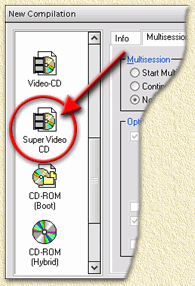 |
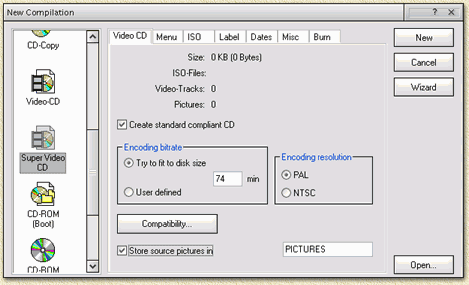
For you're first Super VideoCD I'd like
to suggest to use the settings as seen above. NTSC users
might want to check NTSC instead of PAL.
| Creat standard compliant CD |
Verifies that your VideoCD will be conforming
the standard specification. |
checked |
| Try to fit to disk size |
Leave it checked since it will not impact
on photo Super VideoCD's. |
not checked |
| Encoding resolution |
Specify the format being either PAL (for
example in Europe) or NTSC (USA). It kind-a depends on the movie source
file your using. |
PAL |
| Store source pictures in |
We need this, so Nero will store the original
high resolution images in a seperate folder. This way you can still
access the originals for exmample when you want a hardcopy of an image.
In the Netherlands we know HEMA
and Alber
Heijn offer online services to print digital photo's on photo-paper. |
checked |
Now
go to the next tab, called "Menu".
It is possible to create a Photo-SuperVideoCD without the use of
a menu, however, in order to quickly navigate the CD (and find the photo
you're looking for), a menu is advisable.
So if you are about to create a Super VideoCD
with menu's, please check the option "Enable
menu".
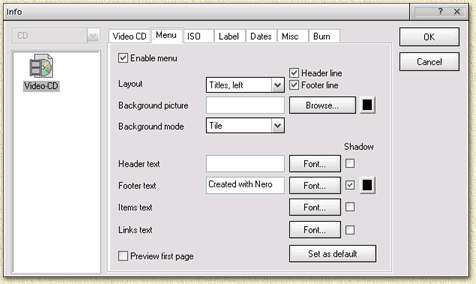
The fields in more detail:
| Tip:
first you might want to check the "Preview first page"
option. It shows a little window with a preview of the menu (changes
are implemented right away!). This window is sizeable so you can see
a bit more of the details. |
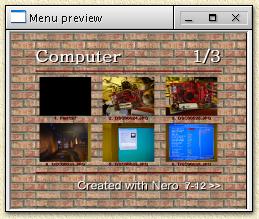 |
| Enable menu |
Enable or disable the menu. |
| Layout |
Here we can define how Nero should layout
the menu. Either using text (titles) or thumbnails. Examples are shown
below. |
| Header line |
Enable or disable the horizontal line
above the titles or thumbnails. |
| Footer line |
Enable or disable the horizontal line just
below the titles or thumbnails. |
| Background picture |
Here you can indicate what image you wish
to use as a background. If you don't enter anything here, the background
will by default be black, You can change that color by clicking the
little black square next to the "Browse..."
button. |
| Background mode |
Here we set the options on how Nero should
use the background image:
- Centered, original dimensions ("center")
- stretched ("maximize") without maintaining
the aspect ratio
- stretched and clipped to create fully filled screen ("scale
and clip" )
- stretched without clipping ("scale and fit")
- or use the image as a pattern ("tile")
|
| Header text |
Here you can enter the page title. You
can leave it empty if you don't want a title.
The button "Font" allows you to choose
font, style and color. The option "shadow"
creates a shadow behind the text. When activating this option, a little
black square appears allowing you to set a different color for the
shadow. |
| Footer text |
Here you can enter the footer text. You
can leave it empty if you don't want a title.
The button "Font" allows you to choose
font, style and color. The option "shadow"
creates a shadow behind the text. When activating this option, a little
black square appears allowing you to set a different color for the
shadow. |
| Items text |
This option allows you to set font, style
and color (note that the color settings influences the color of the
horizontal lines as well!) vof the titles of the menu items. Here
you can activate the use of shadow as well - the shadow will also
be applied to the thumbnails and the horizontal lines. |
| Links text |
Here we set font, style and color for the
indicator in the lower right corner showing the user that there are
more menu pages. The shadow thing works as with the previous items. |
| Set as default |
Allows you to make Nero save these settings
so the next new VideoCD will be started out with the same settings
- ideal when you are creating a serie of VideoCD's.. |
| Preview first page |
Allows you to preview the menu. |
Nero has 9 menu variants, which can be
set at the "Layout" dropdown box:
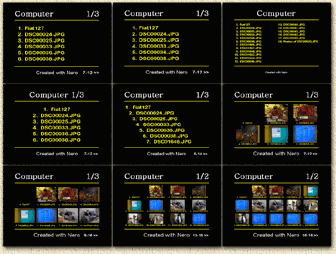
Click the tab "ISO".
Verify that only these options are checked (this is the default setting):
- ISO Level2 (Max. of 31 chars)
- ISO 9660
- Allow pathdepth of more than 8 directories
- Allow more than 255 characters in path
NO other option should be checked!
Now we go to the tab "Label".
In the field "Volume label" we can now
enter the title of our Photo-VideoCD. Usually it's a straight forward
name.
Tip: If a photo collection
spans multiple Foto-VideoCDs, I usually end the title with "_AOFB"
where A equals the disc number in the sequence and B
equals the number of discs in this set.
Note:
In the volume label, special characters like "/", "\"
and a space are not allowed. It is common practice to use an underscore
("_") as a replacement of the space character.
Dates can optionally be set at
the "Dates" tab.
I usually set the date here to "Use current date and time"
for my personal reference, however the default setting will do just fine.
Alternatively you can enter a specific date indicating for example that
this is the photo's are of your holiday of June 2001.
At the "Misc"
tab we do not need to set anything.
The "Burn"
tab is not an issue right now either.
Finally click the "New" button.
Step 3: Adding files.
After we clicked the "New"
button, this compilation windows will appear.
Use drag and drop to place a photo files (usually JPG,
JPEG, BMP or TIFF)
as shown below. Drag and drop can be used with the buildin explorer of
Nero or using the Windows Explorer (by draging a file from the Windows
Explorer to Nero).
For those unfamiliar with drag and drop:
In the right pane you click through the discs of your computer as you
would do with the Windows Explorer. When you finally found the file or
files you want to add, use the left mouse button to select that particular
file and keep the left mouse button pressed. Now move your mouse until
is is positioned over the pane part pointed with the red arrow in the
screenshot below. Once the mouse is at that position, you can release
the mouse button and Nero will add the file.
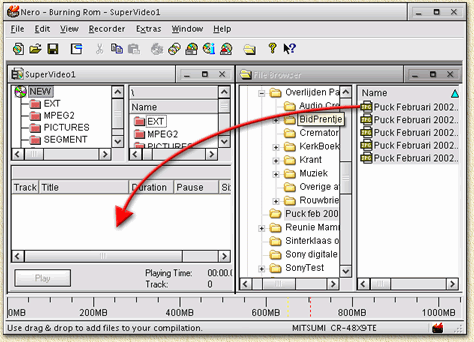
You can add as many photo's as you like. The order shown
in the window pointed by the red arrow as seen in the screenshot above,
will be the playback order of your photos. You can change the order using
drag and drop within this little window.
Note: Sometimes, when you
dragged a illegal photo format to the track section, you will get an error
message. Make sure you're dopping the right files! It is best to use JPEG
of TIFF formatted pictures.
Note that the capacity of
a CD is limited - the amount of space used is visable in the bar at the
bottom of the Nero window, in this screenshot we used about 50 Mb's of
movie data:

Tip:
A Super VideoCD can hold more data on a CD than a regular CDRom. This
is due to the different level of error correction. A 80 minute CDR can
hold app. 810 Mb of VideoCD data. So the indicators (the yellow and red
dotted lines in the progress bar) are not indicating the proper capacity.
Corrections
on the menu
Sometimes it can be usefull to do some
corrections on the menu as it has been created by Nero. For example: to
change the fact that a menu automatically continues to the next menu after
5 seconds.
In the window holding the tracks of your
Super VideoCD, you will see both movies (for example here "Puck
Februari 200...") and menu's ("Menu page 1"
as seen below):
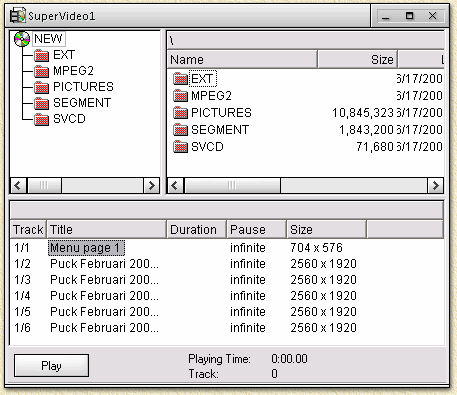
Click such an item with the right mouse
button and select the option "Properties" from
the popup menu.
- For menu pages;
We can set the "pause" time before the menu continues to the
next menu page. At "Pause after Track" one
can choose "Infinite", where the menu does
not continue to the next menu unless the user tells him to do so, or
a specified number of "Seconds".
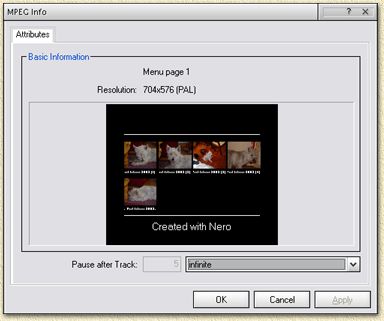
- With photos;
We can set the "pause" time before the playback continues
with the next photo. At "Pause after Track"
one can choose "Infinite", where playback
does not continue to the next movie unless the user tells him to do
so, or a specified number of "Seconds".
The tab "Menu" allows you to change the title
for this item.
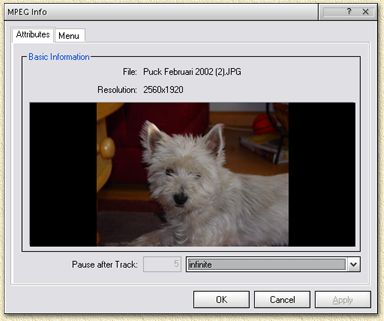 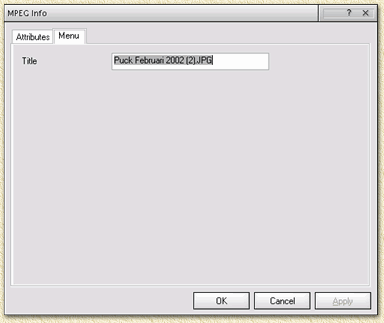
Step 4: Burning the VideoCD
OK, now we've made our compilation, it's time to burn
that puppy.
Click the "Burn" icon ( )
or click in the "File" menu, the option "Write
CD ...". )
or click in the "File" menu, the option "Write
CD ...".
The "New compilation" window
appears again, this time showing the "Burn"
tab.
Here you can choose to simulate and test the writing proces but if you
have done this before I'd go for these options:
- "Write"
- "Finalize CD (No further writing possible!)"
- "Write Speed" set to maximum
- "Write method" set to
"Disc-at-once" (not all CD-writers support
this - in that case select "Track-at-once")
- "Number of copies" set
to "1" unless you want more copies
- Activate "Burnproof" or
"Exalink" if available (not all writers support
this)
Finally click the "Write"
button and wait for the CD to complete.
After the CD has been completely burned, you can try
it on your PC using (for example) PowerDVD, or play it on your standalone
DVD player to see if it all works.
Tip:
You will need a capable DVD playback program to play this CD! Some DVD
playback programs do not even support this format!
Don't forget: a copy of the
original image files are stored in the CD-folder PICTURES.
|














